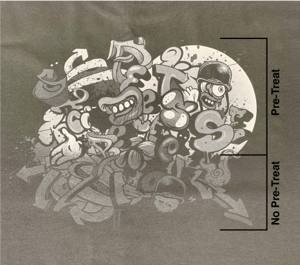Are you new to direct-to-garment printing? Maybe you're in need a refresher. This page covers the essential information you need if you're planning to order digital printing on apparel.
The Basics of Digital Printing is a handy reference that can be downloaded.
Direct-To-Garment (aka DTG or digital) printing is a process used to customize apparel, such as t-shirts, tank tops etc, for promotional merchandise and/or uniforms. (If you are looking for digital printing on unsewn fabric, check out Contrado.) This process was developed to combat the labor intensive set ups (exposing screens, mixing inks, setting up press) associated with screenprinting, making DTG a less expensive option for small orders. The DTG printing process sends a digital art file directly from a computer to a specially designed printer that can print on fabric.
The answer to this question is not cut-and-dry. Digital printing on t shirts is better than screen printing in some instances and screen printing on t shirts is better than digital printing in other instances. Which decoration process to choose depends on the following factors:
Consult with your decorator to determine the best method considering these factors.
View shirt example using a digital and screen printed side-by-side print comparison.
Digital printing on fabric works just like a color inkjet printer you may have in your office. Cyan, magenta, yellow, and black (CMYK) inks are sprayed onto a surface. In your office, the surface may be a piece of paper. In a printshop, the surface may be a t-shirt or other piece of clothing.
In your office, you probably can’t print on black paper because the inks won’t show up. In a printshop, you can print on black t-shirts thanks to the white underbase. A white underbase is a layer of white ink printed first when decorating colored apparel. White underbases are well known in use when screenprinting. Unlike screenprinting, fabrics go through an additional step called pre-treating when printing direct-to-garment.
Here's a look at direct-to-garment printing in action:
Pre-treat is a nontoxic primer used in digital printing on dark garments. Pre-treat helps bond the white underbase ink to the garment’s fabric fiber. Without pre-treating the t-shirt, the DTG white underbase ink won't stick! On the example shown, the print has been pre-treated on the top, but not on the bottom.
 Pre-treat is sprayed on the shirt, then the shirt is heat pressed to create an even smoother surface for printing on. Traces of pre-treat may be visible around the printed image on the finished product, especially when the garments are light blue, light pink, grey, or neon. These visible traces usually come out after the first wash, but if you are printing on these colors be sure to consult with your decorator. It’s a good idea to order a pre-production sample so there are no quality surprises when the order is received by your client. Your decorator can also help you come up with an alternate option that may print better.
Pre-treat is sprayed on the shirt, then the shirt is heat pressed to create an even smoother surface for printing on. Traces of pre-treat may be visible around the printed image on the finished product, especially when the garments are light blue, light pink, grey, or neon. These visible traces usually come out after the first wash, but if you are printing on these colors be sure to consult with your decorator. It’s a good idea to order a pre-production sample so there are no quality surprises when the order is received by your client. Your decorator can also help you come up with an alternate option that may print better.
Garments for DTG printing must be 100% cotton. The smoother the fabric, the nicer the print, so prints on ringspun cotton look better than prints on a regular cotton t-shirt.
Direct-to-garment inks are water-based. Polyester is a kind of plastic. Since plastic doesn’t absorb water, DTG ink does not work on polyester garments. Also stay away from any apparel that is stain resistant or weather proofed. These garments are treated with coatings that repel water and water-based inks.
Polyester makes up close to half of the material in heather color tshirts, so they are not good for digital printing. The Heather Prism series from Bella + Canvas, style 3001CVC is an exception. These t-shirts are 99% airlume combed and ringspun cotton (only 1% polyester), making them a great candidate for direct-to-garment printing.
Also note that most hoodies & fleece are NOT 100% cotton, but the SS450 Independent Trading Co Midweight Hooded Pullover Sweatshirt is 80% cotton, making it a solid choice.
Both high resolution files and vector graphics work for direct-to-garment printing. You can send over the art just as you would for screen print or embroidery. Raster images should be created at a minimum of 150 dpi and up to 300 dpi, if possible. If you’re supplying vector graphics, convert all fonts to outlines and be sure any linked files are embedded or included separately.
Unlike screen printing, Pantone or other color matching is not possible when printing direct-to-garment. Color tweaks or minor adjustments are not possible when printing direct-to-garment.
Yes. While there are no set up fees, associated with DTG printing, volume discounts are based on the number of pieces ordered per design print size. For example you may want to order toddler shirts with a front print of 5" wide and you also want to order the same design on adult shirts printed at 10" wide. The toddler shirts will be counted as one order and the adult shirts will be counted as a separate order. If you order toddler shirts and adult shirts with the design printed at 5" on all the shirts, all pieces can be on the same order.
 Can I print the same design on a variety of sizes & styles?
Can I print the same design on a variety of sizes & styles?Whether or not you can use the same size design for a mix of garment sizes is determined on a case-by-base basis. The range of sizes in a mix and the look you are going for will best determine if you can run all the shirts together. A print that looks perfect on a youth small shirt might look too small on an adult large shirt.
If you are interested in maxing out the printable size, the size of the pallet on the DTG printer comes into question. We've developed a sizing guide to help figure out may different print sizes you want for your order.
The per print price for digital printing is calculated using the quantity you are ordering and the size of the print. Below is an example of a pricing grid for white t-shirts.
| Quantity | 5" x 5" | 5"x5" - 10"x10" | 10"x10" - 14"x15" | 14"x15" - 14"x18" |
| 1-10 | 3.00 | 5.00 | 6.00 | 8.15 |
| 11-23 | 2.50 | 4.00 | 4.75 | 6.85 |
| 24-47 | 2.00 | 3.00 | 3.75 | 5.85 |
| 48-144 | 1.75 | 2.50 | 3.25 | 5.35 |
| 145+ | Contact For Pricing | Contact For Pricing | Contact For Pricing | Contact For Pricing |
White and very light t-shirts are priced differently than color fabrics because a white underbase is needed. You can download the full price list for more information about the cost of direct-to-garment printing as well as turnaround times, recommendations, spoilage allowance and other information.
Direct-to-garment (also called DTG or digital) printing revolutionized printing full color images on low quantity t-shirt orders. Most folks in the promotional products industry are familiar with the process, but many aren’t sure when or why to order DTG prints. This guide has been developed to equip you with the information you will need to make informed choices about direct-to-garment printing.
Just fill out the form on the right to download the guide.
In my years in the t-shirt printing business, I’ve realized buying and owning tshirts is an emotional thing. Whether people are buying a shirt from a store or ordering shirts for an event it is usually very personal.
Direct-to-garment makes printing accessible for people to create shirts of their very own.

George Kilian, President & Founder gkilian@sharprint.com
Digital printing has been in the industry as long as I have and I'm amazed at how digital printing technology has advanced over the past several years.
Some of the newest presses even combine direct-to-garment printing in line on a screen printing press. The best of both worlds with practically limitless capabilities!

Jack Kilian, VP of Sales jkilian@sharprint.com